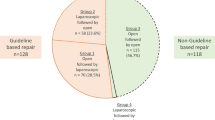Abstract
Background
Hernia is especially prevalent in developing countries where the population is obliged to undertake strenuous work in order to survive, and International Cooperation Programmes are helping to solve this problem. However, the quality of surgical interventions is unknown. The objective of the present study was to evaluate the quality of hernia repair processes carried out by the Surgical Solidarity Charity in Central African States.
Materials and methods
A total of 524 cases of inguinal hernia repair carried out in Cameroon and Mali during 2005 to 2009 were compared with 386 cases treated in a Multicentre Spanish Study (2003). General data (clinical, demographic, etc.), type of surgery, complications, and effectiveness and efficiency indicators were collected.
Results
Preoperative studies in the Spanish group were greater in number than in the African group. The use of local anesthesia was similar. Antibiotic prophylaxis was higher in the African group (100 % to 75.4 %). The use of mesh was similar. The incidence of hematomas was higher in the Spanish group (11.61 % to 4.61 %), but the incidence of infection of the wound and of hernia recurrence was similar, although follow-up was only carried out in 20.97 % in the African group (70 % in the Spanish group). Hospital stay of more than 24 h was higher in the Spanish group.
Conclusions
The standard quality of surgery for the treatment of hernia in developing countries with few instrumental means, and in sub-optimal surgical conditions is similar to that provided in Spain.
Similar content being viewed by others
References
Sanders DL, Porter CS, Mitchell KC et al (2008) A prospective cohort study comparing the African and European hernia. Hernia 12:527–529
Kingsnorth AN, Oppong C, Akoh J et al (2006) Operation hernia to Ghana. Hernia 10:376–379
Turaga KK, Garg N, Coeling M et al (2006) Inguinal hernia repair in a developing country. Hernia 10:294–298
Forte A, Leonetti G, Bosco M et al (2006) Complications of the Lichtenstein inguinal hernioplasty. G Chir 27:368–371
Gourgiotis S, Germanos S, Stratopoulos C et al (2006) Lichtenstein tension-free repair of inguinal hernia. Chirurgia (Bucur) 101:509–512
Amid PK (2005) Groin hernia repair: open techniques. World J Surg 29:1046–1051. doi:10.1007/s00268-005-7967-x; Review
Gürleyik E, Gürleyik G, Cetinkaya F et al (2000) The inflammatory response to open tension-free inguinal hernioplasty versus conventional repair. Am J Surg 179:76
Vatansev C, Belviranli M, Aksoy F et al (2002) The effects of different hernia repair methods on postoperative pain medication and CRP levels. Surg Laparosc Endosc Percutan Tech 12:243–246
Amid PK (2004) Lichtenstein tension-free hernioplasty: its inception, evolution, and principles. Hernia 8:1–7
Simons MP, Aufenacker T, Bay-Nielsen M et al (2009) European Hernia Society guidelines on the treatment of inguinal hernia in adult patients. Hernia 13:343–403
Clarke MG, Oppong C, Simmermacher R et al (2009) The use of sterilised polyester mosquito net mesh for inguinal hernia repair in Ghana. Hernia 13:155–159
Wilhelm TJ, Freudenberg S, Jonas E et al (2007) Sterilized mosquito net versus commercial mesh for hernia repair. an experimental study in goats in Mbarara/Uganda. Eur Surg Res 39:312–317
Rodríguez-Cuellar E, Villeta R, Ruiz P et al (2005) National Project for the Management of Clinical Processes. Surgical treatment of inguinal hérnia. Cir Esp 77:194–202
Alcalde J, Ruiz P, Acosta F et al (2001) Protocol of preoperative evaluation in planned surgery. Cir Esp 69:584–590
Osifo O, Amusan TI (2010) Outcomes of giant inguinoscrotal hernia repair with local lidocaine anesthesia. Saudi Med J 31:53–58
Rathmell JP, Lair TR, Nauman B (2005) The role of intrathecal drugs in the treatment of acute pain. Anesth Analg 101:S30–S43
Aufenacker TJ, Koelemay MJ, Gouma DJ et al (2006) Systematic review and meta-analysis of the effectiveness of antibiotic prophylaxis in prevention of wound infection after mesh repair of abdominal wall hernia. Br J Surg 93:891–892
Sanchez-Manuel FJ, Lozano-García J, Seco-Gil JL (2004) Antibiotic prophylaxis for hernia repair. Cochrane Database Syst Rev 2004;(4)CD003769
Sanabria A, Domínguez LC, Valdivieso E et al (2008) Prophylactic antiboitics for mesh inguinal hernioplasty: a meta-analysis. Ann Surg 247:395–396
Rutkow IM (2003) Demographic and socioeconomic aspects of hernia repair in the U.S. in 2003. Clin Quirur Norteam 5:1019–1025
Fränneby U, Sandblom G, Nyrén O et al (2008) Self-reported adverse events after groin hernia repair, a study based on a national register. Value Health 11:927–932
Carbonell Tatay F (2002) Inguial hernia: concepts, abbreviations, trends and common sense. Cir Esp 71:171–172
Stephenson BM (2003) Complications of open groin hernia repairs. Surg Clin North Am 83:1255–1278
Nilsson E, Haapaniemi S (1998) Hernia register and surgical specialization. Surg Clin North Am 78:1071–1084
Holland WW, The EC Working Group on Health Services and Avoidable Death, eds. (1997) European Community Atlas of Avoidable Death 1985–1989, 3rd Edition, Oxford, Oxford University Press
EU Hernia Trialists Collaboration (2000) Laparoscopic compared with open methods of groin hernia repair: systemic review of randomized trials. Br J Surg 87:860–867
Author information
Authors and Affiliations
Corresponding author
Rights and permissions
About this article
Cite this article
Gil, J., Rodríguez, J.M., Hernández, Q. et al. Do Hernia Operations in African International Cooperation Programmes Provide Good Quality?. World J Surg 36, 2795–2801 (2012). https://doi.org/10.1007/s00268-012-1768-9
Published:
Issue Date:
DOI: https://doi.org/10.1007/s00268-012-1768-9




